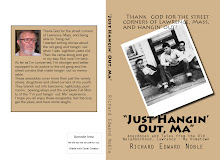On debt ceiling and Republican obstruction.
Robert Reich
Sunday, January 13, 2013
Friday, January 04, 2013
On Killing
On Killing
Lt. Col. Dave Grossman
Book Review
By Richard E. Noble
I was expecting this book to be an expose of the needless and barbaric, brutalization of American youth and their transformation from loving, innocent teenagers into conscienceless, military assassins.
This is not such a book.
This book written by a military officer is a basic description of military indoctrination practices, and an explanation of why they have been enacted. It is not only a defense of the military and its traditions but a declaration of why these practices are a just and moral necessity for the proper protection of the country, its citizens and the average teenage American soldier trainee.
From the peacenik’s point of view this book is an American horror story.
From the authoritarian, militarist perspective this book is a reasonable and logical explanation of the way things are the way they are and why they must be the way they are.
The author’s philosophy is simplistic and basic:
1) War is a fact.
2) That war is a fact necessitates the need for soldiers.
3) That it is a fact that soldiers are necessary, it is a moral imperative that the nation train and condition their soldiers to kill efficiently, expeditiously, without hesitation, guilt or remorse. Soldiers must be mentally prepared to kill the enemy. If proper training in killing is lacking the soldiers will be killed themselves and their country will not be protected.
And it is as simple as that.
But there are basic problems that result from the above necessities. These problems have very little to do with military practices according to this author. They are the problems of our civilian society and polity and its responsibility to its soldiering community.
I will simplify the author’s basic problem:
We begin with a young, wholesome, properly indoctrinated child. The child has been raised in our democratic society and has incorporated all the proper values. He/she has learned to be peace loving and to avoid conflict and aggressive entanglements: no fighting in the school yard, no biting, no kicking, no punching. He has been trained to be a good little boy or girl.
Now this properly, socially adjusted child reaches military age and volunteers to be a patriotic part of the national fabric serving in the necessary defense of the nation.
He/she must be transformed into a killer. A soldier must be a killer. It is necessary to their personal survival that they are given the equipment and the psychological skills to kill effectively and without hesitation.
The military knows how to do this. It has been learning and passing down these techniques and basic training practices for over 2000 years. These proper and morally necessitated techniques are learned in our traditional basic training practices and at our officers training academies.
All of this is proper, moral and acceptable to this author. The problem comes when our trained killer completes his military duty and attempts to rejoin a peaceful, democratic society once again. Now our conditioned, trained, soldier killer must be transformed back into a non-aggressive, social citizen.
This is the author’s scope of interest for the first 300 pages.
This transition has not been going all that well and it is primarily the fault of the citizenry. We were seriously lacking in this respect with our returning Vietnam veterans. We the general public must be made to understand what we have done to these children. Also the political system must be better informed. More money must be allocated to the reclamation and desensitization of our properly trained soldiers.
Not just wounded veterans but all our returning soldiers.
In effect, they must all be put in a psychological decompression chamber. The soldiers must be confirmed in the notion that they have done nothing wrong and that they have acted righteously. We, the public, must be warmer, more gracious, more approving and more supportive. We should have more parades honoring soldiers and soldering. We should give out more metals and ribbons honoring what they have done. We should celebrate our military more often and more elaborately. We should provide returning soldiers with more support groups, more clubs and easier access to more services whatever their problems may be. We need to supply to them more slaps on the back, more hugs and embraces, more TLC and national approval. After all we gave them the problems they are now experiencing. It is our fault. We have a moral obligation to do more and to do it better.
For this officer/author, America has acted correctly in all of its military encounters. America is and has been good; its enemies have been bad. This knowledge is all a soldier needs to proceed forward in America’s defense programs abroad.
For example, he dismisses all the debate over Vietnam in one paragraph. His argument is that history has now proven that the Viet Cong were Communists.
That’s it. Case closed.
Like the military tribunals assigned to make the judgments at Nuremberg this author/militarist has great trouble in distinguishing between an atrocity and proper, normal military, moral, necessary killing. What would appear to most of us as a clear and obvious distinction becomes a muddled mire of over simplistic misinterpretations, at least according the author’s authoritarian, militarist mindset.
I personally think that this officer/author is an interesting study in how the typical, average authoritarian, militarist mind operates. This guy is a study unto himself.
But once we get past page 300 we get into a little different twist. This final section of the book deals with the application of the killing technologies used so effectively in military indoctrination being made available to the general public and especially children in the form of video games, Hollywood movies and the desensitization of our children and the general population to blood, gore, unauthorized violence and killing.
It is the author’s contention in this section that, these killing techniques and processes of desensitizing of the individual warrior, though perfectly legitimate for the training and indoctrination of teenage soldiers, is a total horror when released indiscriminately onto our children and the general public. He would like to see certain video games, those recreating real humans being killed complete with blood and scattering brain and body parts, taken off the market. He would like to see violent movies censored or regulated. He sees problems with our new Hollywood anti-heroes and the basic notion that it is acceptable for civilians or even authorized police or investigators to take the law into their own hands.
Like the majority of Americans the author has a double standard. Most Americans are perfectly willing to abandon the Constitution, the Bill of Right and our entire freedom loving, democratic system in the stern face of Military necessity. This author takes that abandonment to an even higher level with his killing machine notions. Most Americans and this author are able to compartmentalize their value system and incorporate two acceptable systems. One that applies to military and war and another that applies to civilian life. This is the main reason, in my opinion, for all of our confusion on this subject. In one area the killing and murder of women, children, old men and non-combatants are considered warranted and necessary and in the other a slap in the face or even a spiteful remark are looked upon as possibly criminal and subject to legal sanction and prosecution.
I find most of my personal agreement with the author in this last small section of the book.
Overall, I think this book was a good experience. I think peaceniks and warmongers will both find lots of food for thought in this text.
The book is filled with facts and studies and with an equal number of the author’s personal opinions or insights. I would put the author’s insights in the 50/50 category. Half of them I can accept and half of them I find lacking in proper interpretation.
The author is fearful that without proper regulation of videos, movies, Hollywood and gun regulation we risk turning our country into a Nazi-like Germany. Yet he is not at all fearful that the very same technologies, indoctrination and techniques when applied to our young trainee soldiers will turn our military personnel into a Nazi-like SS or Einsatzguppen.
We must remember the defense of the committed Nazi, “We were only following orders.” This counters the author’s main defense of soldering and proper moral killing that in the military, soldiers must follow orders and therefore their actions are controlled and regulated.
Nazism is the most recent historical proof that “following orders” is far from an effective barrier in defense of an authoritarian military structure.
It is my opinion that the author will always have big problems with moral decisions because of his obvious acceptance of militarism and its dehumanizing aspects.
This author is first and foremost a soldier. As a soldier and militarist he must find a method for justifying killing. Once this adaptation is established all moral questions with regards to killing become obfuscated and confusing.
The value of this book, in my opinion, is not whether it is true or false. It is the psychological opportunity provided to the reader of a concise, rational, educated and unheated presentation of the American modern-day authoritarian/militarist outlook and overall justification for war and killing.
I have already dealt in great detail with this basic authoritarian/militarist point of view in my book “Mein Kampf – An Analysis of Book One.”
In Adolf’s book he justifies war and killing by claiming that it is all a part of Nature’s Divine Plan. Adolf taught that War is good.
This author starts his justification from what I would call the Winston Churchill position. Which is, like it or not, war is an unfortunate but necessary evil.
This author does not go as far as Winston in that he says simply that war and killing are necessary. He doesn’t mention evil in his basic justification. He states simply that war and the consequent killing are necessary – and he adds that the killing is not only necessary but moral. A country that didn’t train its soldiers to become conditioned killing experts would be acting immorally, the author claims.
I would also say that this is the accepted point of view of most Americans.
The author’s personal opinions and interpretations of the facts that he presents of what and how this acceptance of war and killing should be dealt with by America and its government is controversial to say the least. His basic moral acceptance of the methods used by the military to indoctrinate and fortify killing expertise in its soldiers should be evaluated by all Americans.
After all, his ideas and the practices that he describes and teaches ARE what your young adults are being taught presently in the American military.
Lt. Col. Dave Grossman
Book Review
By Richard E. Noble
I was expecting this book to be an expose of the needless and barbaric, brutalization of American youth and their transformation from loving, innocent teenagers into conscienceless, military assassins.
This is not such a book.
This book written by a military officer is a basic description of military indoctrination practices, and an explanation of why they have been enacted. It is not only a defense of the military and its traditions but a declaration of why these practices are a just and moral necessity for the proper protection of the country, its citizens and the average teenage American soldier trainee.
From the peacenik’s point of view this book is an American horror story.
From the authoritarian, militarist perspective this book is a reasonable and logical explanation of the way things are the way they are and why they must be the way they are.
The author’s philosophy is simplistic and basic:
1) War is a fact.
2) That war is a fact necessitates the need for soldiers.
3) That it is a fact that soldiers are necessary, it is a moral imperative that the nation train and condition their soldiers to kill efficiently, expeditiously, without hesitation, guilt or remorse. Soldiers must be mentally prepared to kill the enemy. If proper training in killing is lacking the soldiers will be killed themselves and their country will not be protected.
And it is as simple as that.
But there are basic problems that result from the above necessities. These problems have very little to do with military practices according to this author. They are the problems of our civilian society and polity and its responsibility to its soldiering community.
I will simplify the author’s basic problem:
We begin with a young, wholesome, properly indoctrinated child. The child has been raised in our democratic society and has incorporated all the proper values. He/she has learned to be peace loving and to avoid conflict and aggressive entanglements: no fighting in the school yard, no biting, no kicking, no punching. He has been trained to be a good little boy or girl.
Now this properly, socially adjusted child reaches military age and volunteers to be a patriotic part of the national fabric serving in the necessary defense of the nation.
He/she must be transformed into a killer. A soldier must be a killer. It is necessary to their personal survival that they are given the equipment and the psychological skills to kill effectively and without hesitation.
The military knows how to do this. It has been learning and passing down these techniques and basic training practices for over 2000 years. These proper and morally necessitated techniques are learned in our traditional basic training practices and at our officers training academies.
All of this is proper, moral and acceptable to this author. The problem comes when our trained killer completes his military duty and attempts to rejoin a peaceful, democratic society once again. Now our conditioned, trained, soldier killer must be transformed back into a non-aggressive, social citizen.
This is the author’s scope of interest for the first 300 pages.
This transition has not been going all that well and it is primarily the fault of the citizenry. We were seriously lacking in this respect with our returning Vietnam veterans. We the general public must be made to understand what we have done to these children. Also the political system must be better informed. More money must be allocated to the reclamation and desensitization of our properly trained soldiers.
Not just wounded veterans but all our returning soldiers.
In effect, they must all be put in a psychological decompression chamber. The soldiers must be confirmed in the notion that they have done nothing wrong and that they have acted righteously. We, the public, must be warmer, more gracious, more approving and more supportive. We should have more parades honoring soldiers and soldering. We should give out more metals and ribbons honoring what they have done. We should celebrate our military more often and more elaborately. We should provide returning soldiers with more support groups, more clubs and easier access to more services whatever their problems may be. We need to supply to them more slaps on the back, more hugs and embraces, more TLC and national approval. After all we gave them the problems they are now experiencing. It is our fault. We have a moral obligation to do more and to do it better.
For this officer/author, America has acted correctly in all of its military encounters. America is and has been good; its enemies have been bad. This knowledge is all a soldier needs to proceed forward in America’s defense programs abroad.
For example, he dismisses all the debate over Vietnam in one paragraph. His argument is that history has now proven that the Viet Cong were Communists.
That’s it. Case closed.
Like the military tribunals assigned to make the judgments at Nuremberg this author/militarist has great trouble in distinguishing between an atrocity and proper, normal military, moral, necessary killing. What would appear to most of us as a clear and obvious distinction becomes a muddled mire of over simplistic misinterpretations, at least according the author’s authoritarian, militarist mindset.
I personally think that this officer/author is an interesting study in how the typical, average authoritarian, militarist mind operates. This guy is a study unto himself.
But once we get past page 300 we get into a little different twist. This final section of the book deals with the application of the killing technologies used so effectively in military indoctrination being made available to the general public and especially children in the form of video games, Hollywood movies and the desensitization of our children and the general population to blood, gore, unauthorized violence and killing.
It is the author’s contention in this section that, these killing techniques and processes of desensitizing of the individual warrior, though perfectly legitimate for the training and indoctrination of teenage soldiers, is a total horror when released indiscriminately onto our children and the general public. He would like to see certain video games, those recreating real humans being killed complete with blood and scattering brain and body parts, taken off the market. He would like to see violent movies censored or regulated. He sees problems with our new Hollywood anti-heroes and the basic notion that it is acceptable for civilians or even authorized police or investigators to take the law into their own hands.
Like the majority of Americans the author has a double standard. Most Americans are perfectly willing to abandon the Constitution, the Bill of Right and our entire freedom loving, democratic system in the stern face of Military necessity. This author takes that abandonment to an even higher level with his killing machine notions. Most Americans and this author are able to compartmentalize their value system and incorporate two acceptable systems. One that applies to military and war and another that applies to civilian life. This is the main reason, in my opinion, for all of our confusion on this subject. In one area the killing and murder of women, children, old men and non-combatants are considered warranted and necessary and in the other a slap in the face or even a spiteful remark are looked upon as possibly criminal and subject to legal sanction and prosecution.
I find most of my personal agreement with the author in this last small section of the book.
Overall, I think this book was a good experience. I think peaceniks and warmongers will both find lots of food for thought in this text.
The book is filled with facts and studies and with an equal number of the author’s personal opinions or insights. I would put the author’s insights in the 50/50 category. Half of them I can accept and half of them I find lacking in proper interpretation.
The author is fearful that without proper regulation of videos, movies, Hollywood and gun regulation we risk turning our country into a Nazi-like Germany. Yet he is not at all fearful that the very same technologies, indoctrination and techniques when applied to our young trainee soldiers will turn our military personnel into a Nazi-like SS or Einsatzguppen.
We must remember the defense of the committed Nazi, “We were only following orders.” This counters the author’s main defense of soldering and proper moral killing that in the military, soldiers must follow orders and therefore their actions are controlled and regulated.
Nazism is the most recent historical proof that “following orders” is far from an effective barrier in defense of an authoritarian military structure.
It is my opinion that the author will always have big problems with moral decisions because of his obvious acceptance of militarism and its dehumanizing aspects.
This author is first and foremost a soldier. As a soldier and militarist he must find a method for justifying killing. Once this adaptation is established all moral questions with regards to killing become obfuscated and confusing.
The value of this book, in my opinion, is not whether it is true or false. It is the psychological opportunity provided to the reader of a concise, rational, educated and unheated presentation of the American modern-day authoritarian/militarist outlook and overall justification for war and killing.
I have already dealt in great detail with this basic authoritarian/militarist point of view in my book “Mein Kampf – An Analysis of Book One.”
In Adolf’s book he justifies war and killing by claiming that it is all a part of Nature’s Divine Plan. Adolf taught that War is good.
This author starts his justification from what I would call the Winston Churchill position. Which is, like it or not, war is an unfortunate but necessary evil.
This author does not go as far as Winston in that he says simply that war and killing are necessary. He doesn’t mention evil in his basic justification. He states simply that war and the consequent killing are necessary – and he adds that the killing is not only necessary but moral. A country that didn’t train its soldiers to become conditioned killing experts would be acting immorally, the author claims.
I would also say that this is the accepted point of view of most Americans.
The author’s personal opinions and interpretations of the facts that he presents of what and how this acceptance of war and killing should be dealt with by America and its government is controversial to say the least. His basic moral acceptance of the methods used by the military to indoctrinate and fortify killing expertise in its soldiers should be evaluated by all Americans.
After all, his ideas and the practices that he describes and teaches ARE what your young adults are being taught presently in the American military.
Subscribe to:
Posts (Atom)





































